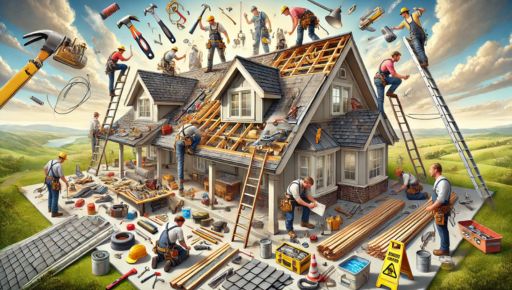The Ultimate Guide to Roof Repairing: Tips, Techniques, and Professional Help
Introduction
Roof repairing is one of the most important maintenance tasks that homeowners should never ignore. A well-maintained roof not only ensures the safety and comfort of your home but also helps you save money in the long run by preventing costly damages. Whether you’re dealing with a leaky roof, cracked shingles, or general wear and tear, understanding the basics of roof repair can go a long way. In this comprehensive guide, we’ll explore essential roof repairing tips, common issues, and when it’s time to call a professional.
Why Roof Repairing is Essential
A well-maintained roof plays a critical role in protecting your home from the elements. It shields your property from rain, snow, and harsh weather, as well as keeps your home insulated and energy-efficient. Regular roof repairing can help prevent minor problems from escalating into major repairs, saving you money and preserving the longevity of your roof.
Common Roof Repairing Issues
Before diving into roof repairs, it’s important to understand the common problems that homeowners face. Some of the most frequent roof issues include:
- Leaking Roofs: Water stains on ceilings or walls often indicate a leak. Leaks are caused by damaged shingles, clogged gutters, or compromised flashing.
- Cracked or Missing Shingles: Severe weather conditions, age, and regular wear can cause shingles to crack, warp, or go missing. This exposes your roof to potential water damage.
- Damaged Flashing: Flashing is used around chimneys, vents, and skylights to prevent water from seeping underneath the roof. Damaged or corroded flashing can lead to leaks and water intrusion.
- Clogged Gutters: Over time, gutters accumulate debris such as leaves, twigs, and dirt. Clogged gutters can cause water to pool on the roof, leading to leaks and other damage.
- Moss and Algae Growth: In damp or shaded areas, moss and algae can begin to grow on your roof, which can trap moisture and cause shingles to degrade faster.
When to Repair Your Roof
Not all roof issues require immediate attention, but ignoring necessary repairs can lead to bigger problems. Here are some signs it’s time to consider roof repairing:
- Visible Roof Damage: If you notice cracked, missing, or curled shingles, it’s a clear sign that repairs are needed. These issues expose the roof structure to water damage and further deterioration.
- Water Damage Inside the Home: Stains or dampness on walls and ceilings could indicate a leaky roof. If left unresolved, water can cause mold growth, structural damage, and costly repairs.
- Increased Energy Bills: A compromised roof affects your home’s insulation, causing your heating and cooling systems to work harder. If your energy bills have been rising unexpectedly, your roof may be to blame.
- Moss, Mold, or Algae Growth: If your roof has visible moss or algae buildup, it may indicate trapped moisture or deteriorating shingles. Regular cleaning or repairs may be necessary to prevent further damage.
DIY Roof Repairing: Is It Possible?
Some minor roof repairs can be done by homeowners who are comfortable working at heights and have the proper tools. However, roof repair involves significant risk, and it’s essential to consider whether a DIY approach is safe and feasible. Some simple tasks you might be able to tackle include:
- Replacing Missing Shingles: If you have extra shingles from previous roof work, you can replace the damaged ones yourself. However, it’s important to match the color and style to maintain aesthetic appeal.
- Clearing Gutters and Debris: Keeping your gutters clean is a simple task that can help prevent water buildup and damage. Regularly remove leaves and debris from gutters to maintain their function.
- Sealing Small Leaks: Minor leaks or cracks can be sealed with roofing tar or silicone sealant. This can temporarily prevent water intrusion, but it’s still essential to have the area inspected by a professional.
When to Call a Professional for Roof Repairing
While DIY repairs are possible for minor issues, there are many situations where hiring a professional roofer is the best option. Some scenarios where professional help is essential include:
- Large-Scale Roof Damage: If your roof has sustained significant damage due to a storm or age, it’s crucial to bring in a roofing professional. They have the tools and expertise to handle large repairs or replacements.
- Structural Concerns: If you notice sagging, unusual wear, or signs of rot in your roof, a professional should assess the structure. These issues may require specialized repair techniques to ensure the integrity of your home.
- Complex Leak Problems: Locating and repairing roof leaks can be challenging. Professionals use advanced techniques like thermal imaging to pinpoint leaks and provide effective solutions.
- Safety Concerns: Working on a roof involves risks, especially if you’re not experienced. Professional roofers have the right equipment and training to perform repairs safely.
Choosing the Right Roof Repairing Professional
When hiring a roofer, it’s essential to choose a reputable and experienced professional. Here are some tips for selecting the right expert:
- Do Your Research: Look for companies with positive reviews and a proven track record of quality work.
- Check Licensing and Insurance: Ensure the roofing contractor is licensed and insured to protect yourself from liability and subpar work.
- Get Multiple Quotes: Before committing to a roofer, get quotes from multiple professionals to ensure fair pricing.
- Ask About Warranty: A good roofing company will offer a warranty for both materials and labor, giving you peace of mind in case something goes wrong.
Conclusion
Roof repairing is a crucial part of home maintenance that ensures the safety, comfort, and longevity of your property. By staying vigilant and addressing minor issues before they become major problems, you can extend the life of your roof and avoid expensive repairs. Whether you choose to tackle small repairs yourself or hire a professional for complex issues, keeping your roof in top condition is essential for protecting your home and family.

